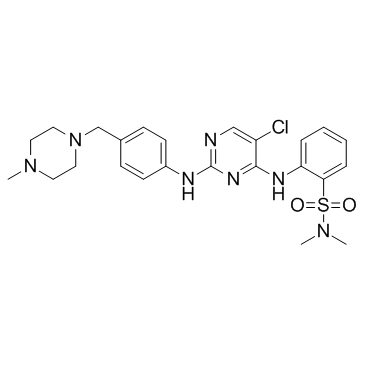| Description |
TP-0903 is a potent and selective Axl receptor tyrosine kinase inhibitor with an IC50 value of 27 nM.
|
| Related Catalog |
|
| Target |
IC50: 27nM (Axl)[1]
|
| In Vitro |
TP-0903 displays a potent activity against AXL with an IC50 of 0.027 μM. TP-0903 shows extremely potent activity in cell viability assays with an IC50 of 6 nM against the pancreatic cancer cell line PSN-1. TP-0903 is evaluated for its ability to block GAS6-mediated activation of AXL in pancreatic cancer cells. PSN-1 cells are serum-starved and then stimulated with GAS6 in the presence of various concentrations of TP-0903[1].
|
| Kinase Assay |
TP-0903 is diluted in kinase reaction buffer and are briefly incubated with Axl kinase. The reaction is initiated by the addition of ATP and fluorescein-labeled poly-GT substrate. Concentration of the various components in the assay (10 μL reaction volume) are: 1% DMSO, 93 ng/mL Axl kinase, 20 μL ATP, and 200 nM fluorescein poly-GT substrate. The incubation is for 60 min at room temperature, the enzyme reaction is stopped by addition of 10 μL terbium-labeled anti-phosphotyrosine PY20 antibody in EDTA-containing buffer. Final concentration of EDTA and antibody after addition to the reaction is 10 mM and 2 nM, respectively. After one hour incubation at room temperature, fluorescence is measured with excitation of 320 nm and dual emission of 495 and 520 nm on an microplate reader[1].
|
| Cell Assay |
For cell proliferation assays, 45 μL containing 1000 cells per well are seeded into solid white 384-well plates in appropriate media. The following day, TP-0903 is diluted in serum free growth media to 10x desired concentrations and 5 μL is added to each well. Combined compound and cells are incubated for 96 hours. Following incubation, 40 μL of ATP-Lite solution is added to each well, incubated for an additional 10 minutes at room temperature and luminescence is measured on an microplate reader[1].
|
| References |
[1]. Mollard A, et al. Design, Synthesis and Biological Evaluation of a Series of Novel Axl Kinase Inhibitors. ACS Med Chem Lett. 2011 Dec 8;2(12):907-912.
|
